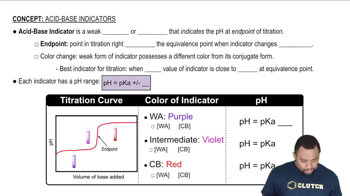Here are the essential concepts you must grasp in order to answer the question correctly.
Acid-Base Titration
An acid-base titration is a quantitative analytical method used to determine the concentration of an acid or base in a solution. It involves the gradual addition of a titrant (a solution of known concentration) to a sample until the reaction reaches its equivalence point, where the amount of acid equals the amount of base. The choice of indicator is crucial, as it signals the endpoint of the titration through a color change.
Recommended video:
Indicators
Indicators are substances that change color at a specific pH range, making them useful for determining the endpoint of a titration. Different indicators are suitable for different types of titrations based on the pH at which the equivalence point occurs. For titrations involving strong acids and weak bases, such as CH3NH2 (methylamine), an indicator that changes color in the acidic pH range is typically selected.
Recommended video:
pH and pKa
pH is a measure of the acidity or basicity of a solution, while pKa is the negative logarithm of the acid dissociation constant (Ka) of a weak acid. The pKa value helps predict the pH at which an acid or base will be half dissociated. In the context of titration, knowing the pKa of the weak base (like CH3NH2) allows for the selection of an appropriate indicator that will change color at the pH corresponding to the equivalence point of the titration.
Recommended video:




